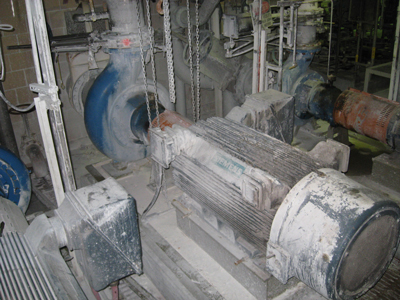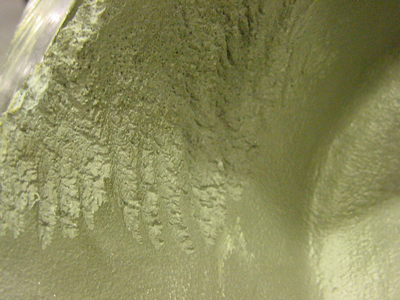The International Paper plant in Courtland, Ala., had experienced problems with a white water pump on a paper machine since the plant installed the pump in the late 1970s. The problem pump experienced high vibration levels, ranging from 0.6 to 0.7 in/s. These high vibration levels reduced the pump's overall reliability and contributed to bearing failures, bearing defects, packing failures, misalignment and impeller damage.
The pump's mean time between failures averaged nine months. Since the pump had a failure rate of 1.33 times per year, the potential for affecting machine production was high. Because of the chronic nature of this pump, more resources than usual were required to ensure it did not interrupt production. Closely watching pump vibration and operating temperatures was critical for managing the pump's poor reliability.
Nothing seemed to solve the high vibration on the problem pump; precision maintenance using laser alignment, precision balancing of impellers to a G1 specification, new pump rotating assemblies, new pump casings and wear plates, and new coupling assemblies all proved ineffective.
The plant finally turned to root cause failure analysis (RCFA) to devise a solution to the vibration and reliability problem. "The Root Cause Failure Analysis (RCFA) process was key to resolving the pump reliability issues," says Randy Riddell, mechanical reliability engineer at International Paper. "The RCFA process focused our efforts on the specific failure modes of the pump, which directed the team toward the root cause and eventual solutions. This improvement was the result of many people's efforts over more than a decade of troubleshooting and analysis."
While previous investigations into the pump cavitation issues did not reveal any issues since NPSHA > NPSHR (NPSHA = 38 ft, NPSHR = 23 ft), the evidence on the pump impeller and the vibration signature revealed a different story. The impeller had cavitation damage on the low pressure side of the impeller, indicating a suction issue (see Figure 1).

Figure 1. Typical pump impeller cavitation damage.
As the RCFA process steered the investigation toward the cavitation problem, it was discovered that the pump operated with high suction energy. This high suction energy created an NPSH margin = 2.5 to suppress cavitation for this particular pump's operating point. With the NPSHR increasing to 58 ft, the NPSHA remained at 38 ft. Under these operating conditions, the resulting cavitation energy was determined the root cause of the high vibration and poor pump reliability.
The plant investigated numerous options, including installing variable frequency drives, lowering the speed of the problem pump or installing another pump. Due to increased costs and installation issues with variable frequency drives, that option was not chosen. Slowing down the existing pump was not feasible because it would not support the process demands at a lower speed.
The plant ultimately chose to install a different pump designed for the paper machine application and run it at a slower speed than the original pump. The new pump had a much lower suction energy-50 percent less than the previous pump-and NPSHR = 11 ft with the system NPSHA = 38 ft. This new pump solved the cavitation issue and met the process demands of the paper machine.
The solution drastically reduced the pump's overall vibration by 89 percent from 0.6-0.7 in/s to 0.08 in/s and removed the pump cavitation. The pump's adjusted design operating point, which lowered the head by 40 ft and increased pump efficiency by 8 percent, reduced its energy consumption by approximately 30 percent. By operating the new pump closer to BEP, shaft loads were lowered, which decreased shaft deflection.
Using a premium efficiency TEFC motor, the plant saw the pump motor operating temperature decrease 75 deg F. This reduced the thermal growth misalignment from .006 to .001 in and improved motor reliability. The pump bearing temperatures decreased by 30 deg F, which improved lubricant life and performance. Other improvements included the use of a dynamic seal, a disc coupling and improved foundation geometry. Shaft stiffness improved by 80 percent.
The reliability improvements extended beyond the pump. The reduced energy consumption resulted in more reliability for control valves in the system; valves that had been run 20 to 30 percent open now operate 50 to 70 percent open.
In nearly five years since the new pump was installed, it has not needed any maintenance work. This is important as the location of this pump is not easily accessible due to surrounding pumps and other piping (see Figure 2).

Figure 2. New Paper Machine White Water Pump
This RCFA provided key lessons that can be applied to other areas of the plant. The mill has already taken these findings to other problem pumps. One such pump has recently been installed based on these findings with positive results. The results have not only been shared across the mill, but also within International Paper to help improve pump reliability within the company.
"This project signifies the spirit of the Courtland Mill team with its dedication to reliability as the key driver in how we manage our business," Riddell says.

